Physiology 101 Assignment: Body's Response to Starvation and Fasting
VerifiedAdded on 2021/06/17
|12
|3336
|131
Homework Assignment
AI Summary
This assignment delves into the physiological differences between starvation and fasting, examining the body's metabolic responses to these conditions. It explores the three phases of the body's reaction to starvation, including gluconeogenesis, ketosis, and glycogenolysis, with a focus on how the liver, kidneys, and muscles adapt to maintain blood glucose levels and energy production. The assignment also discusses the role of the lymphatic system and glucose transporters in these processes, providing a detailed overview of the Cori cycle and the utilization of ketone bodies by the brain and other vital organs. The assignment highlights the impact of starvation and fasting on various bodily systems and metabolic pathways, providing a comprehensive analysis of the body's adaptations to energy deprivation.

1
Topics in Physiology
Name
Date of Submission
Topics in Physiology
Name
Date of Submission
Paraphrase This Document
Need a fresh take? Get an instant paraphrase of this document with our AI Paraphraser
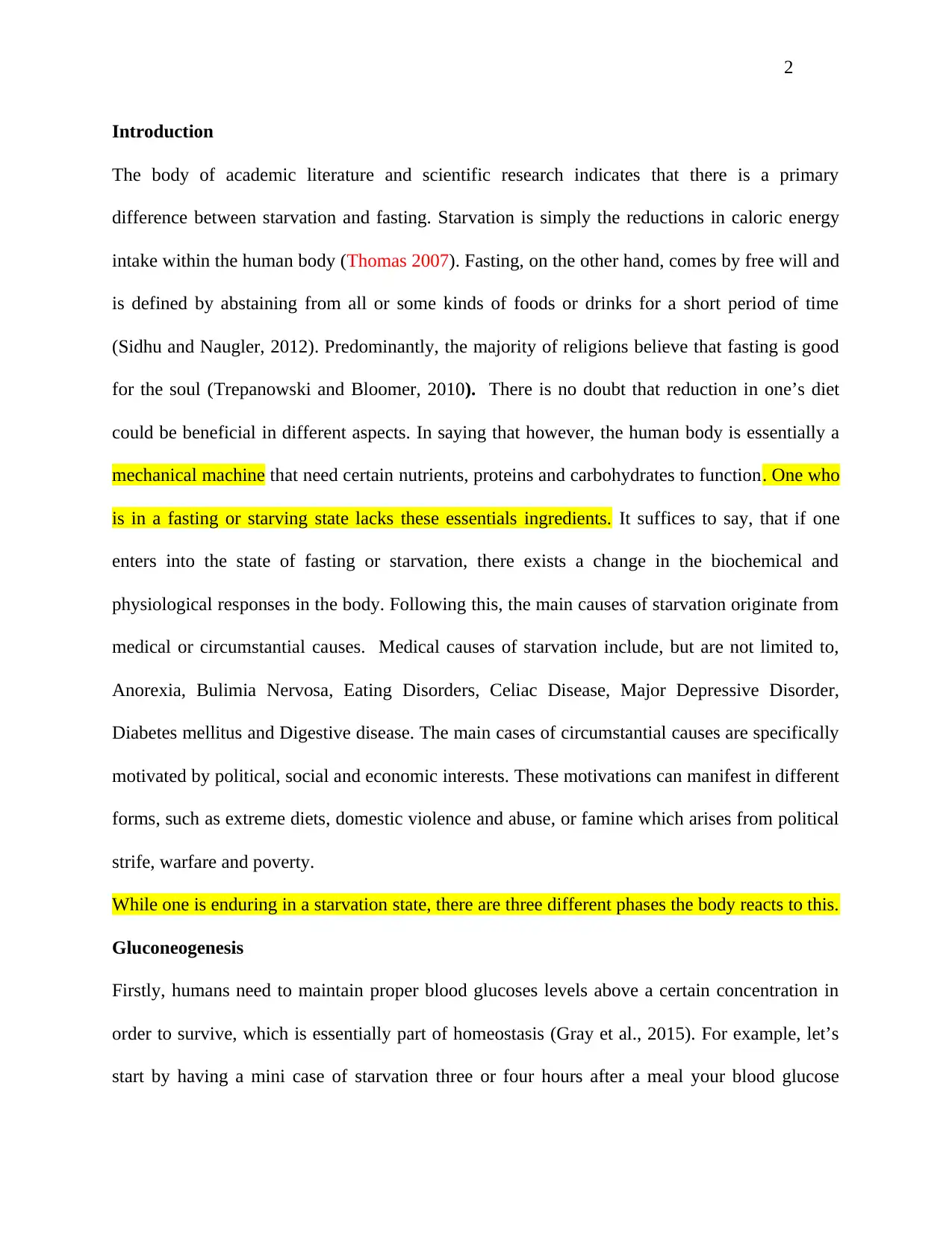
2
Introduction
The body of academic literature and scientific research indicates that there is a primary
difference between starvation and fasting. Starvation is simply the reductions in caloric energy
intake within the human body (Thomas 2007). Fasting, on the other hand, comes by free will and
is defined by abstaining from all or some kinds of foods or drinks for a short period of time
(Sidhu and Naugler, 2012). Predominantly, the majority of religions believe that fasting is good
for the soul (Trepanowski and Bloomer, 2010). There is no doubt that reduction in one’s diet
could be beneficial in different aspects. In saying that however, the human body is essentially a
mechanical machine that need certain nutrients, proteins and carbohydrates to function. One who
is in a fasting or starving state lacks these essentials ingredients. It suffices to say, that if one
enters into the state of fasting or starvation, there exists a change in the biochemical and
physiological responses in the body. Following this, the main causes of starvation originate from
medical or circumstantial causes. Medical causes of starvation include, but are not limited to,
Anorexia, Bulimia Nervosa, Eating Disorders, Celiac Disease, Major Depressive Disorder,
Diabetes mellitus and Digestive disease. The main cases of circumstantial causes are specifically
motivated by political, social and economic interests. These motivations can manifest in different
forms, such as extreme diets, domestic violence and abuse, or famine which arises from political
strife, warfare and poverty.
While one is enduring in a starvation state, there are three different phases the body reacts to this.
Gluconeogenesis
Firstly, humans need to maintain proper blood glucoses levels above a certain concentration in
order to survive, which is essentially part of homeostasis (Gray et al., 2015). For example, let’s
start by having a mini case of starvation three or four hours after a meal your blood glucose
Introduction
The body of academic literature and scientific research indicates that there is a primary
difference between starvation and fasting. Starvation is simply the reductions in caloric energy
intake within the human body (Thomas 2007). Fasting, on the other hand, comes by free will and
is defined by abstaining from all or some kinds of foods or drinks for a short period of time
(Sidhu and Naugler, 2012). Predominantly, the majority of religions believe that fasting is good
for the soul (Trepanowski and Bloomer, 2010). There is no doubt that reduction in one’s diet
could be beneficial in different aspects. In saying that however, the human body is essentially a
mechanical machine that need certain nutrients, proteins and carbohydrates to function. One who
is in a fasting or starving state lacks these essentials ingredients. It suffices to say, that if one
enters into the state of fasting or starvation, there exists a change in the biochemical and
physiological responses in the body. Following this, the main causes of starvation originate from
medical or circumstantial causes. Medical causes of starvation include, but are not limited to,
Anorexia, Bulimia Nervosa, Eating Disorders, Celiac Disease, Major Depressive Disorder,
Diabetes mellitus and Digestive disease. The main cases of circumstantial causes are specifically
motivated by political, social and economic interests. These motivations can manifest in different
forms, such as extreme diets, domestic violence and abuse, or famine which arises from political
strife, warfare and poverty.
While one is enduring in a starvation state, there are three different phases the body reacts to this.
Gluconeogenesis
Firstly, humans need to maintain proper blood glucoses levels above a certain concentration in
order to survive, which is essentially part of homeostasis (Gray et al., 2015). For example, let’s
start by having a mini case of starvation three or four hours after a meal your blood glucose
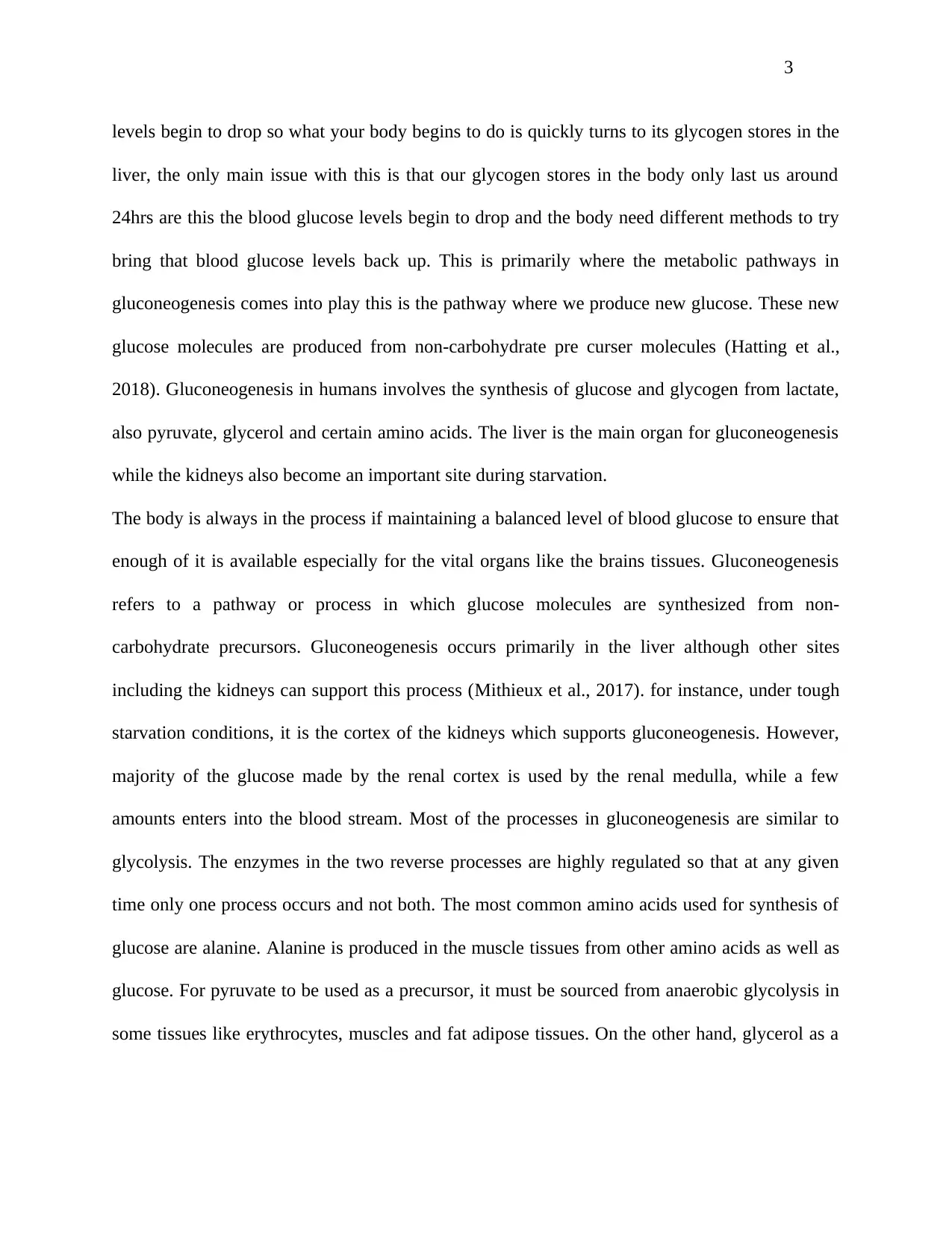
3
levels begin to drop so what your body begins to do is quickly turns to its glycogen stores in the
liver, the only main issue with this is that our glycogen stores in the body only last us around
24hrs are this the blood glucose levels begin to drop and the body need different methods to try
bring that blood glucose levels back up. This is primarily where the metabolic pathways in
gluconeogenesis comes into play this is the pathway where we produce new glucose. These new
glucose molecules are produced from non-carbohydrate pre curser molecules (Hatting et al.,
2018). Gluconeogenesis in humans involves the synthesis of glucose and glycogen from lactate,
also pyruvate, glycerol and certain amino acids. The liver is the main organ for gluconeogenesis
while the kidneys also become an important site during starvation.
The body is always in the process if maintaining a balanced level of blood glucose to ensure that
enough of it is available especially for the vital organs like the brains tissues. Gluconeogenesis
refers to a pathway or process in which glucose molecules are synthesized from non-
carbohydrate precursors. Gluconeogenesis occurs primarily in the liver although other sites
including the kidneys can support this process (Mithieux et al., 2017). for instance, under tough
starvation conditions, it is the cortex of the kidneys which supports gluconeogenesis. However,
majority of the glucose made by the renal cortex is used by the renal medulla, while a few
amounts enters into the blood stream. Most of the processes in gluconeogenesis are similar to
glycolysis. The enzymes in the two reverse processes are highly regulated so that at any given
time only one process occurs and not both. The most common amino acids used for synthesis of
glucose are alanine. Alanine is produced in the muscle tissues from other amino acids as well as
glucose. For pyruvate to be used as a precursor, it must be sourced from anaerobic glycolysis in
some tissues like erythrocytes, muscles and fat adipose tissues. On the other hand, glycerol as a
levels begin to drop so what your body begins to do is quickly turns to its glycogen stores in the
liver, the only main issue with this is that our glycogen stores in the body only last us around
24hrs are this the blood glucose levels begin to drop and the body need different methods to try
bring that blood glucose levels back up. This is primarily where the metabolic pathways in
gluconeogenesis comes into play this is the pathway where we produce new glucose. These new
glucose molecules are produced from non-carbohydrate pre curser molecules (Hatting et al.,
2018). Gluconeogenesis in humans involves the synthesis of glucose and glycogen from lactate,
also pyruvate, glycerol and certain amino acids. The liver is the main organ for gluconeogenesis
while the kidneys also become an important site during starvation.
The body is always in the process if maintaining a balanced level of blood glucose to ensure that
enough of it is available especially for the vital organs like the brains tissues. Gluconeogenesis
refers to a pathway or process in which glucose molecules are synthesized from non-
carbohydrate precursors. Gluconeogenesis occurs primarily in the liver although other sites
including the kidneys can support this process (Mithieux et al., 2017). for instance, under tough
starvation conditions, it is the cortex of the kidneys which supports gluconeogenesis. However,
majority of the glucose made by the renal cortex is used by the renal medulla, while a few
amounts enters into the blood stream. Most of the processes in gluconeogenesis are similar to
glycolysis. The enzymes in the two reverse processes are highly regulated so that at any given
time only one process occurs and not both. The most common amino acids used for synthesis of
glucose are alanine. Alanine is produced in the muscle tissues from other amino acids as well as
glucose. For pyruvate to be used as a precursor, it must be sourced from anaerobic glycolysis in
some tissues like erythrocytes, muscles and fat adipose tissues. On the other hand, glycerol as a
⊘ This is a preview!⊘
Do you want full access?
Subscribe today to unlock all pages.

Trusted by 1+ million students worldwide
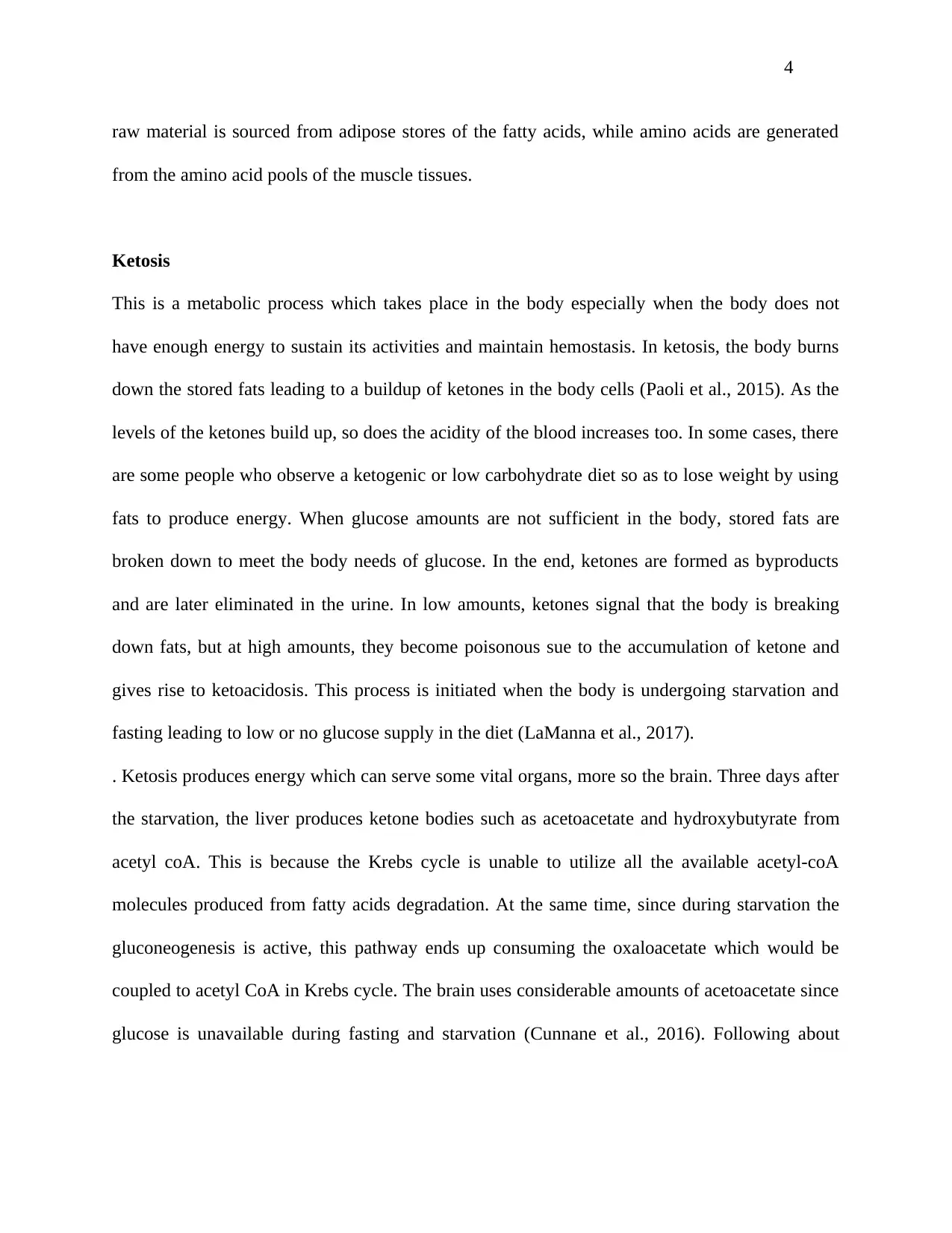
4
raw material is sourced from adipose stores of the fatty acids, while amino acids are generated
from the amino acid pools of the muscle tissues.
Ketosis
This is a metabolic process which takes place in the body especially when the body does not
have enough energy to sustain its activities and maintain hemostasis. In ketosis, the body burns
down the stored fats leading to a buildup of ketones in the body cells (Paoli et al., 2015). As the
levels of the ketones build up, so does the acidity of the blood increases too. In some cases, there
are some people who observe a ketogenic or low carbohydrate diet so as to lose weight by using
fats to produce energy. When glucose amounts are not sufficient in the body, stored fats are
broken down to meet the body needs of glucose. In the end, ketones are formed as byproducts
and are later eliminated in the urine. In low amounts, ketones signal that the body is breaking
down fats, but at high amounts, they become poisonous sue to the accumulation of ketone and
gives rise to ketoacidosis. This process is initiated when the body is undergoing starvation and
fasting leading to low or no glucose supply in the diet (LaManna et al., 2017).
. Ketosis produces energy which can serve some vital organs, more so the brain. Three days after
the starvation, the liver produces ketone bodies such as acetoacetate and hydroxybutyrate from
acetyl coA. This is because the Krebs cycle is unable to utilize all the available acetyl-coA
molecules produced from fatty acids degradation. At the same time, since during starvation the
gluconeogenesis is active, this pathway ends up consuming the oxaloacetate which would be
coupled to acetyl CoA in Krebs cycle. The brain uses considerable amounts of acetoacetate since
glucose is unavailable during fasting and starvation (Cunnane et al., 2016). Following about
raw material is sourced from adipose stores of the fatty acids, while amino acids are generated
from the amino acid pools of the muscle tissues.
Ketosis
This is a metabolic process which takes place in the body especially when the body does not
have enough energy to sustain its activities and maintain hemostasis. In ketosis, the body burns
down the stored fats leading to a buildup of ketones in the body cells (Paoli et al., 2015). As the
levels of the ketones build up, so does the acidity of the blood increases too. In some cases, there
are some people who observe a ketogenic or low carbohydrate diet so as to lose weight by using
fats to produce energy. When glucose amounts are not sufficient in the body, stored fats are
broken down to meet the body needs of glucose. In the end, ketones are formed as byproducts
and are later eliminated in the urine. In low amounts, ketones signal that the body is breaking
down fats, but at high amounts, they become poisonous sue to the accumulation of ketone and
gives rise to ketoacidosis. This process is initiated when the body is undergoing starvation and
fasting leading to low or no glucose supply in the diet (LaManna et al., 2017).
. Ketosis produces energy which can serve some vital organs, more so the brain. Three days after
the starvation, the liver produces ketone bodies such as acetoacetate and hydroxybutyrate from
acetyl coA. This is because the Krebs cycle is unable to utilize all the available acetyl-coA
molecules produced from fatty acids degradation. At the same time, since during starvation the
gluconeogenesis is active, this pathway ends up consuming the oxaloacetate which would be
coupled to acetyl CoA in Krebs cycle. The brain uses considerable amounts of acetoacetate since
glucose is unavailable during fasting and starvation (Cunnane et al., 2016). Following about
Paraphrase This Document
Need a fresh take? Get an instant paraphrase of this document with our AI Paraphraser
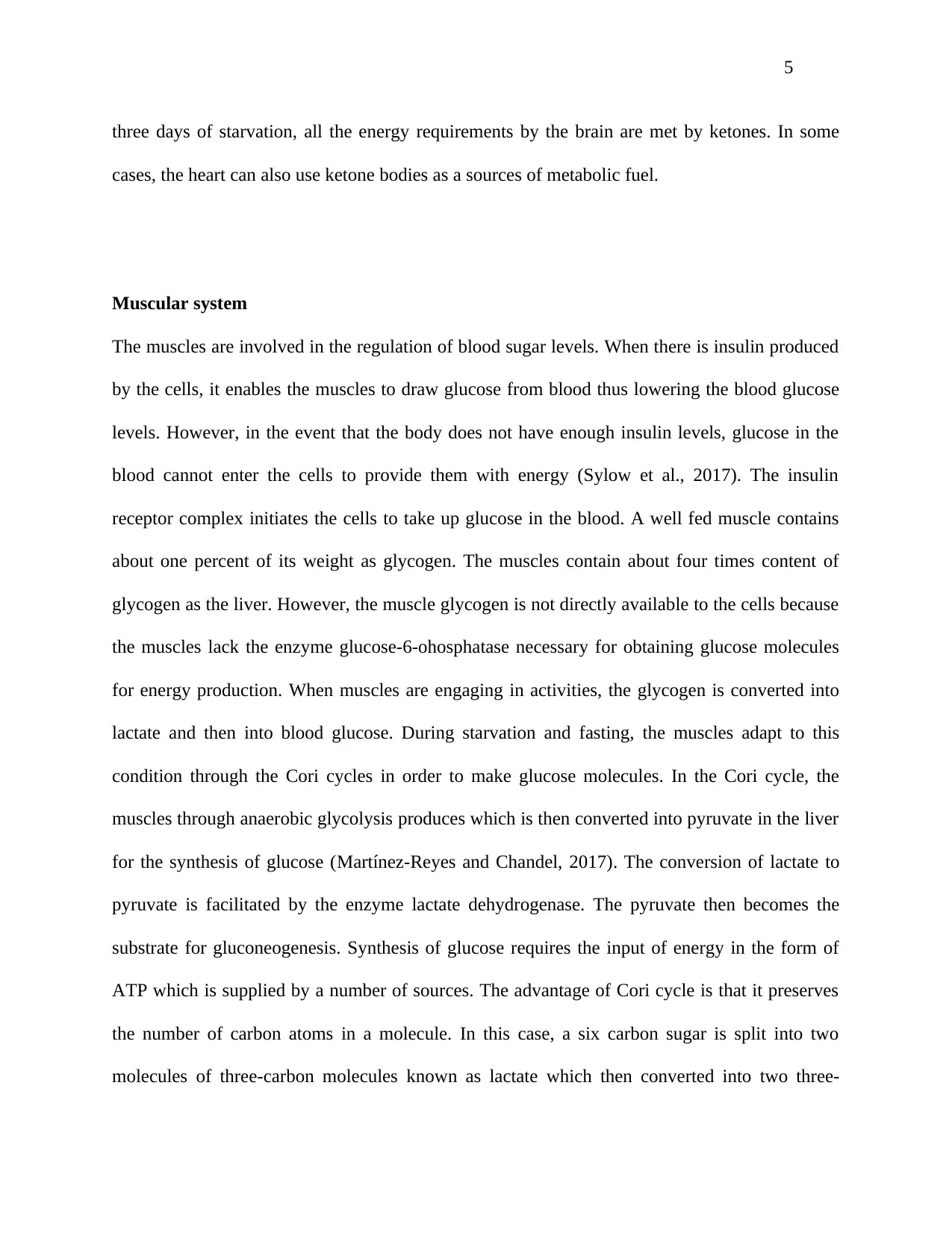
5
three days of starvation, all the energy requirements by the brain are met by ketones. In some
cases, the heart can also use ketone bodies as a sources of metabolic fuel.
Muscular system
The muscles are involved in the regulation of blood sugar levels. When there is insulin produced
by the cells, it enables the muscles to draw glucose from blood thus lowering the blood glucose
levels. However, in the event that the body does not have enough insulin levels, glucose in the
blood cannot enter the cells to provide them with energy (Sylow et al., 2017). The insulin
receptor complex initiates the cells to take up glucose in the blood. A well fed muscle contains
about one percent of its weight as glycogen. The muscles contain about four times content of
glycogen as the liver. However, the muscle glycogen is not directly available to the cells because
the muscles lack the enzyme glucose-6-ohosphatase necessary for obtaining glucose molecules
for energy production. When muscles are engaging in activities, the glycogen is converted into
lactate and then into blood glucose. During starvation and fasting, the muscles adapt to this
condition through the Cori cycles in order to make glucose molecules. In the Cori cycle, the
muscles through anaerobic glycolysis produces which is then converted into pyruvate in the liver
for the synthesis of glucose (Martínez-Reyes and Chandel, 2017). The conversion of lactate to
pyruvate is facilitated by the enzyme lactate dehydrogenase. The pyruvate then becomes the
substrate for gluconeogenesis. Synthesis of glucose requires the input of energy in the form of
ATP which is supplied by a number of sources. The advantage of Cori cycle is that it preserves
the number of carbon atoms in a molecule. In this case, a six carbon sugar is split into two
molecules of three-carbon molecules known as lactate which then converted into two three-
three days of starvation, all the energy requirements by the brain are met by ketones. In some
cases, the heart can also use ketone bodies as a sources of metabolic fuel.
Muscular system
The muscles are involved in the regulation of blood sugar levels. When there is insulin produced
by the cells, it enables the muscles to draw glucose from blood thus lowering the blood glucose
levels. However, in the event that the body does not have enough insulin levels, glucose in the
blood cannot enter the cells to provide them with energy (Sylow et al., 2017). The insulin
receptor complex initiates the cells to take up glucose in the blood. A well fed muscle contains
about one percent of its weight as glycogen. The muscles contain about four times content of
glycogen as the liver. However, the muscle glycogen is not directly available to the cells because
the muscles lack the enzyme glucose-6-ohosphatase necessary for obtaining glucose molecules
for energy production. When muscles are engaging in activities, the glycogen is converted into
lactate and then into blood glucose. During starvation and fasting, the muscles adapt to this
condition through the Cori cycles in order to make glucose molecules. In the Cori cycle, the
muscles through anaerobic glycolysis produces which is then converted into pyruvate in the liver
for the synthesis of glucose (Martínez-Reyes and Chandel, 2017). The conversion of lactate to
pyruvate is facilitated by the enzyme lactate dehydrogenase. The pyruvate then becomes the
substrate for gluconeogenesis. Synthesis of glucose requires the input of energy in the form of
ATP which is supplied by a number of sources. The advantage of Cori cycle is that it preserves
the number of carbon atoms in a molecule. In this case, a six carbon sugar is split into two
molecules of three-carbon molecules known as lactate which then converted into two three-
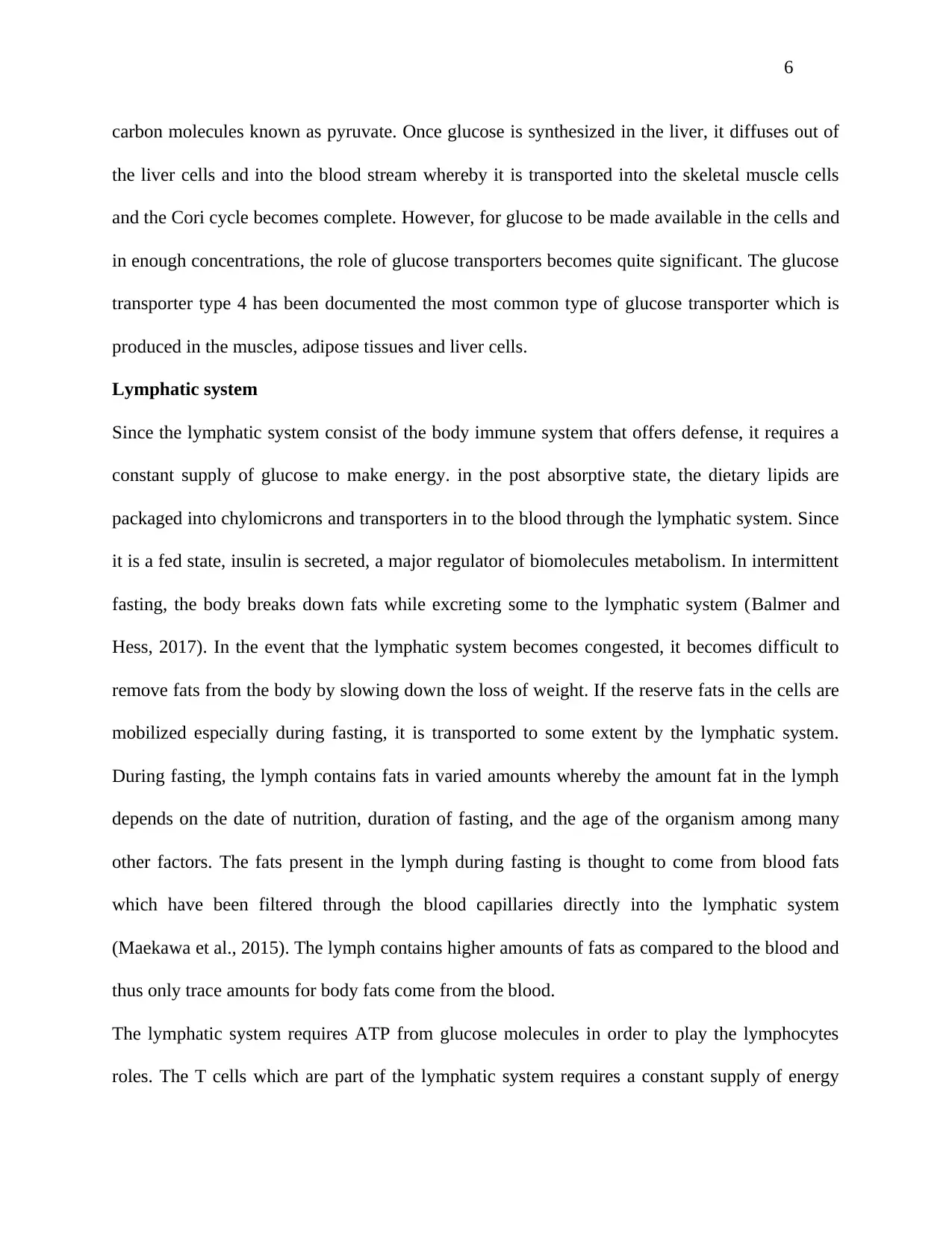
6
carbon molecules known as pyruvate. Once glucose is synthesized in the liver, it diffuses out of
the liver cells and into the blood stream whereby it is transported into the skeletal muscle cells
and the Cori cycle becomes complete. However, for glucose to be made available in the cells and
in enough concentrations, the role of glucose transporters becomes quite significant. The glucose
transporter type 4 has been documented the most common type of glucose transporter which is
produced in the muscles, adipose tissues and liver cells.
Lymphatic system
Since the lymphatic system consist of the body immune system that offers defense, it requires a
constant supply of glucose to make energy. in the post absorptive state, the dietary lipids are
packaged into chylomicrons and transporters in to the blood through the lymphatic system. Since
it is a fed state, insulin is secreted, a major regulator of biomolecules metabolism. In intermittent
fasting, the body breaks down fats while excreting some to the lymphatic system (Balmer and
Hess, 2017). In the event that the lymphatic system becomes congested, it becomes difficult to
remove fats from the body by slowing down the loss of weight. If the reserve fats in the cells are
mobilized especially during fasting, it is transported to some extent by the lymphatic system.
During fasting, the lymph contains fats in varied amounts whereby the amount fat in the lymph
depends on the date of nutrition, duration of fasting, and the age of the organism among many
other factors. The fats present in the lymph during fasting is thought to come from blood fats
which have been filtered through the blood capillaries directly into the lymphatic system
(Maekawa et al., 2015). The lymph contains higher amounts of fats as compared to the blood and
thus only trace amounts for body fats come from the blood.
The lymphatic system requires ATP from glucose molecules in order to play the lymphocytes
roles. The T cells which are part of the lymphatic system requires a constant supply of energy
carbon molecules known as pyruvate. Once glucose is synthesized in the liver, it diffuses out of
the liver cells and into the blood stream whereby it is transported into the skeletal muscle cells
and the Cori cycle becomes complete. However, for glucose to be made available in the cells and
in enough concentrations, the role of glucose transporters becomes quite significant. The glucose
transporter type 4 has been documented the most common type of glucose transporter which is
produced in the muscles, adipose tissues and liver cells.
Lymphatic system
Since the lymphatic system consist of the body immune system that offers defense, it requires a
constant supply of glucose to make energy. in the post absorptive state, the dietary lipids are
packaged into chylomicrons and transporters in to the blood through the lymphatic system. Since
it is a fed state, insulin is secreted, a major regulator of biomolecules metabolism. In intermittent
fasting, the body breaks down fats while excreting some to the lymphatic system (Balmer and
Hess, 2017). In the event that the lymphatic system becomes congested, it becomes difficult to
remove fats from the body by slowing down the loss of weight. If the reserve fats in the cells are
mobilized especially during fasting, it is transported to some extent by the lymphatic system.
During fasting, the lymph contains fats in varied amounts whereby the amount fat in the lymph
depends on the date of nutrition, duration of fasting, and the age of the organism among many
other factors. The fats present in the lymph during fasting is thought to come from blood fats
which have been filtered through the blood capillaries directly into the lymphatic system
(Maekawa et al., 2015). The lymph contains higher amounts of fats as compared to the blood and
thus only trace amounts for body fats come from the blood.
The lymphatic system requires ATP from glucose molecules in order to play the lymphocytes
roles. The T cells which are part of the lymphatic system requires a constant supply of energy
⊘ This is a preview!⊘
Do you want full access?
Subscribe today to unlock all pages.

Trusted by 1+ million students worldwide

7
from glucose. However, the naïve cells need extrinsic function of the cytokines in order to
maintain the continued uptake of glucose for the normal cells activities. In the lymphocytes, the
glucose molecules when available are converted to pyruvate with net release of energy.
However, during starvation and fasting, the pyruvate is used to make energy whereby it is
converted to lactate (Teuwen et al., 2017). Then lactate undergoes a number of processes to
produce NAD+, an electrical acceptor from NADH. These electrons fuel other pathways to
produce energy required for the lymphatic cells. Moreover, in the absence of glucose, or during
the resting state of the lymphatic system, these cells derives energy through oxidative
phosphorylation which oxygen independent. The oxidative phosphorylation involves two stages;
first is the conversion of pyruvate and fatty acids to acetyl CoA molecules, a process carried by
molecules with reducing power, i.e. NADH and FADH2 through the electron transport chain.
Therefore, it is necessary that there is a close monitoring of glucose levels in order to ensure that
a sustained monitoring to maintain an immune hemostasis (Gomes et al., 2016). It is also
necessary to gain some understanding concerning so as to be able to understand the homeostasis
in the body through gaining a detailed understanding and the pathways involved in the various
therapeutic developments. For obvious reasons, once there is a lack of proper blood glucose
supply; or in cases where the control is not closely monitored, then there could be problems in
the synthesis and function of the lymphatic cells. In terms of glucose transporters, it is necessary
to note that the lymphocytes do not have the glucose transporter type 4 but instead has glucose
transporter type 1.
Glycogenolysis
Another route via which the body adapts to starvation or fasting s through glycogenolysis. In this
cases, the stored glucose in form of glycogen is broken down into individual glucose units. The
from glucose. However, the naïve cells need extrinsic function of the cytokines in order to
maintain the continued uptake of glucose for the normal cells activities. In the lymphocytes, the
glucose molecules when available are converted to pyruvate with net release of energy.
However, during starvation and fasting, the pyruvate is used to make energy whereby it is
converted to lactate (Teuwen et al., 2017). Then lactate undergoes a number of processes to
produce NAD+, an electrical acceptor from NADH. These electrons fuel other pathways to
produce energy required for the lymphatic cells. Moreover, in the absence of glucose, or during
the resting state of the lymphatic system, these cells derives energy through oxidative
phosphorylation which oxygen independent. The oxidative phosphorylation involves two stages;
first is the conversion of pyruvate and fatty acids to acetyl CoA molecules, a process carried by
molecules with reducing power, i.e. NADH and FADH2 through the electron transport chain.
Therefore, it is necessary that there is a close monitoring of glucose levels in order to ensure that
a sustained monitoring to maintain an immune hemostasis (Gomes et al., 2016). It is also
necessary to gain some understanding concerning so as to be able to understand the homeostasis
in the body through gaining a detailed understanding and the pathways involved in the various
therapeutic developments. For obvious reasons, once there is a lack of proper blood glucose
supply; or in cases where the control is not closely monitored, then there could be problems in
the synthesis and function of the lymphatic cells. In terms of glucose transporters, it is necessary
to note that the lymphocytes do not have the glucose transporter type 4 but instead has glucose
transporter type 1.
Glycogenolysis
Another route via which the body adapts to starvation or fasting s through glycogenolysis. In this
cases, the stored glucose in form of glycogen is broken down into individual glucose units. The
Paraphrase This Document
Need a fresh take? Get an instant paraphrase of this document with our AI Paraphraser
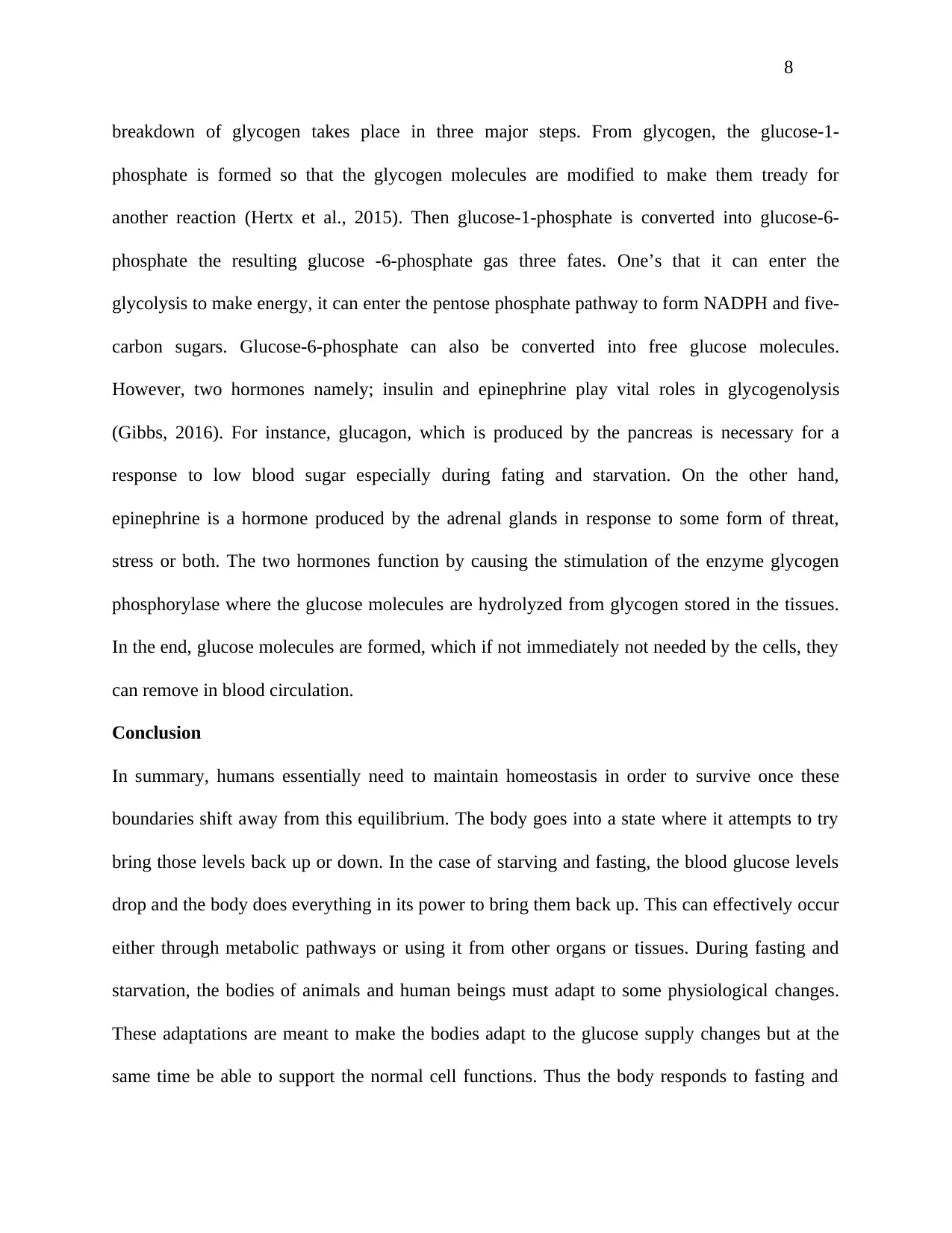
8
breakdown of glycogen takes place in three major steps. From glycogen, the glucose-1-
phosphate is formed so that the glycogen molecules are modified to make them tready for
another reaction (Hertx et al., 2015). Then glucose-1-phosphate is converted into glucose-6-
phosphate the resulting glucose -6-phosphate gas three fates. One’s that it can enter the
glycolysis to make energy, it can enter the pentose phosphate pathway to form NADPH and five-
carbon sugars. Glucose-6-phosphate can also be converted into free glucose molecules.
However, two hormones namely; insulin and epinephrine play vital roles in glycogenolysis
(Gibbs, 2016). For instance, glucagon, which is produced by the pancreas is necessary for a
response to low blood sugar especially during fating and starvation. On the other hand,
epinephrine is a hormone produced by the adrenal glands in response to some form of threat,
stress or both. The two hormones function by causing the stimulation of the enzyme glycogen
phosphorylase where the glucose molecules are hydrolyzed from glycogen stored in the tissues.
In the end, glucose molecules are formed, which if not immediately not needed by the cells, they
can remove in blood circulation.
Conclusion
In summary, humans essentially need to maintain homeostasis in order to survive once these
boundaries shift away from this equilibrium. The body goes into a state where it attempts to try
bring those levels back up or down. In the case of starving and fasting, the blood glucose levels
drop and the body does everything in its power to bring them back up. This can effectively occur
either through metabolic pathways or using it from other organs or tissues. During fasting and
starvation, the bodies of animals and human beings must adapt to some physiological changes.
These adaptations are meant to make the bodies adapt to the glucose supply changes but at the
same time be able to support the normal cell functions. Thus the body responds to fasting and
breakdown of glycogen takes place in three major steps. From glycogen, the glucose-1-
phosphate is formed so that the glycogen molecules are modified to make them tready for
another reaction (Hertx et al., 2015). Then glucose-1-phosphate is converted into glucose-6-
phosphate the resulting glucose -6-phosphate gas three fates. One’s that it can enter the
glycolysis to make energy, it can enter the pentose phosphate pathway to form NADPH and five-
carbon sugars. Glucose-6-phosphate can also be converted into free glucose molecules.
However, two hormones namely; insulin and epinephrine play vital roles in glycogenolysis
(Gibbs, 2016). For instance, glucagon, which is produced by the pancreas is necessary for a
response to low blood sugar especially during fating and starvation. On the other hand,
epinephrine is a hormone produced by the adrenal glands in response to some form of threat,
stress or both. The two hormones function by causing the stimulation of the enzyme glycogen
phosphorylase where the glucose molecules are hydrolyzed from glycogen stored in the tissues.
In the end, glucose molecules are formed, which if not immediately not needed by the cells, they
can remove in blood circulation.
Conclusion
In summary, humans essentially need to maintain homeostasis in order to survive once these
boundaries shift away from this equilibrium. The body goes into a state where it attempts to try
bring those levels back up or down. In the case of starving and fasting, the blood glucose levels
drop and the body does everything in its power to bring them back up. This can effectively occur
either through metabolic pathways or using it from other organs or tissues. During fasting and
starvation, the bodies of animals and human beings must adapt to some physiological changes.
These adaptations are meant to make the bodies adapt to the glucose supply changes but at the
same time be able to support the normal cell functions. Thus the body responds to fasting and
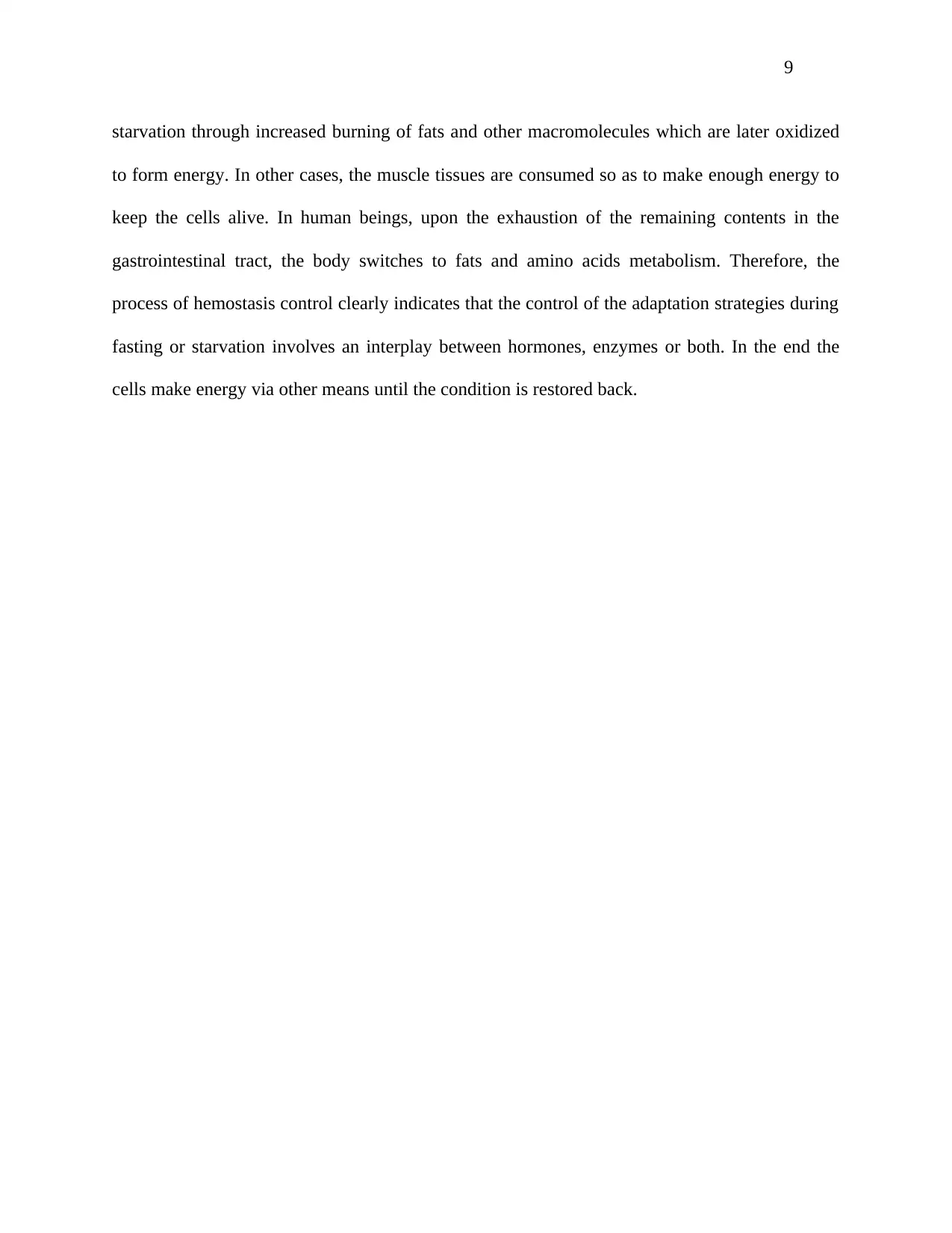
9
starvation through increased burning of fats and other macromolecules which are later oxidized
to form energy. In other cases, the muscle tissues are consumed so as to make enough energy to
keep the cells alive. In human beings, upon the exhaustion of the remaining contents in the
gastrointestinal tract, the body switches to fats and amino acids metabolism. Therefore, the
process of hemostasis control clearly indicates that the control of the adaptation strategies during
fasting or starvation involves an interplay between hormones, enzymes or both. In the end the
cells make energy via other means until the condition is restored back.
starvation through increased burning of fats and other macromolecules which are later oxidized
to form energy. In other cases, the muscle tissues are consumed so as to make enough energy to
keep the cells alive. In human beings, upon the exhaustion of the remaining contents in the
gastrointestinal tract, the body switches to fats and amino acids metabolism. Therefore, the
process of hemostasis control clearly indicates that the control of the adaptation strategies during
fasting or starvation involves an interplay between hormones, enzymes or both. In the end the
cells make energy via other means until the condition is restored back.
⊘ This is a preview!⊘
Do you want full access?
Subscribe today to unlock all pages.

Trusted by 1+ million students worldwide
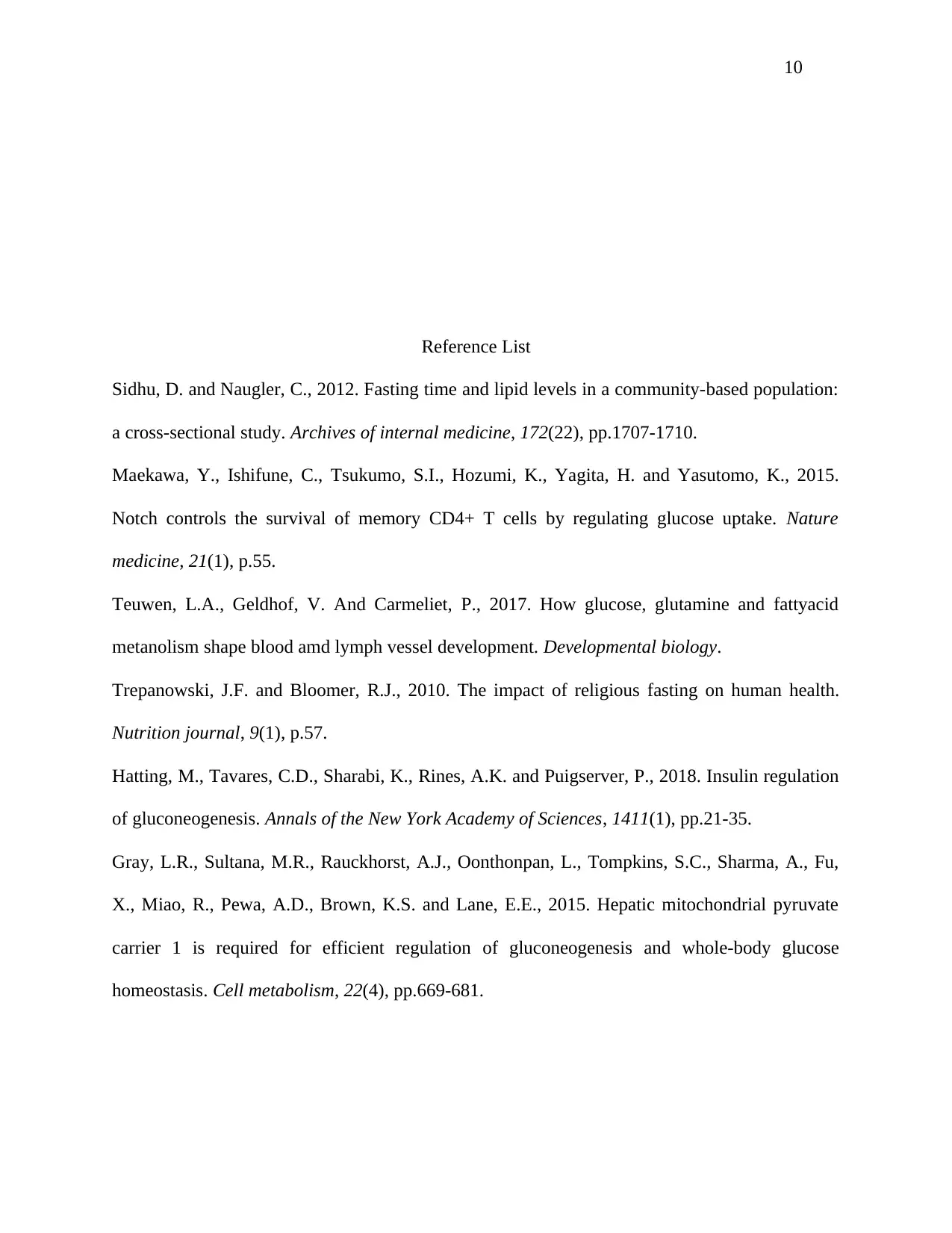
10
Reference List
Sidhu, D. and Naugler, C., 2012. Fasting time and lipid levels in a community-based population:
a cross-sectional study. Archives of internal medicine, 172(22), pp.1707-1710.
Maekawa, Y., Ishifune, C., Tsukumo, S.I., Hozumi, K., Yagita, H. and Yasutomo, K., 2015.
Notch controls the survival of memory CD4+ T cells by regulating glucose uptake. Nature
medicine, 21(1), p.55.
Teuwen, L.A., Geldhof, V. And Carmeliet, P., 2017. How glucose, glutamine and fattyacid
metanolism shape blood amd lymph vessel development. Developmental biology.
Trepanowski, J.F. and Bloomer, R.J., 2010. The impact of religious fasting on human health.
Nutrition journal, 9(1), p.57.
Hatting, M., Tavares, C.D., Sharabi, K., Rines, A.K. and Puigserver, P., 2018. Insulin regulation
of gluconeogenesis. Annals of the New York Academy of Sciences, 1411(1), pp.21-35.
Gray, L.R., Sultana, M.R., Rauckhorst, A.J., Oonthonpan, L., Tompkins, S.C., Sharma, A., Fu,
X., Miao, R., Pewa, A.D., Brown, K.S. and Lane, E.E., 2015. Hepatic mitochondrial pyruvate
carrier 1 is required for efficient regulation of gluconeogenesis and whole-body glucose
homeostasis. Cell metabolism, 22(4), pp.669-681.
Reference List
Sidhu, D. and Naugler, C., 2012. Fasting time and lipid levels in a community-based population:
a cross-sectional study. Archives of internal medicine, 172(22), pp.1707-1710.
Maekawa, Y., Ishifune, C., Tsukumo, S.I., Hozumi, K., Yagita, H. and Yasutomo, K., 2015.
Notch controls the survival of memory CD4+ T cells by regulating glucose uptake. Nature
medicine, 21(1), p.55.
Teuwen, L.A., Geldhof, V. And Carmeliet, P., 2017. How glucose, glutamine and fattyacid
metanolism shape blood amd lymph vessel development. Developmental biology.
Trepanowski, J.F. and Bloomer, R.J., 2010. The impact of religious fasting on human health.
Nutrition journal, 9(1), p.57.
Hatting, M., Tavares, C.D., Sharabi, K., Rines, A.K. and Puigserver, P., 2018. Insulin regulation
of gluconeogenesis. Annals of the New York Academy of Sciences, 1411(1), pp.21-35.
Gray, L.R., Sultana, M.R., Rauckhorst, A.J., Oonthonpan, L., Tompkins, S.C., Sharma, A., Fu,
X., Miao, R., Pewa, A.D., Brown, K.S. and Lane, E.E., 2015. Hepatic mitochondrial pyruvate
carrier 1 is required for efficient regulation of gluconeogenesis and whole-body glucose
homeostasis. Cell metabolism, 22(4), pp.669-681.
Paraphrase This Document
Need a fresh take? Get an instant paraphrase of this document with our AI Paraphraser
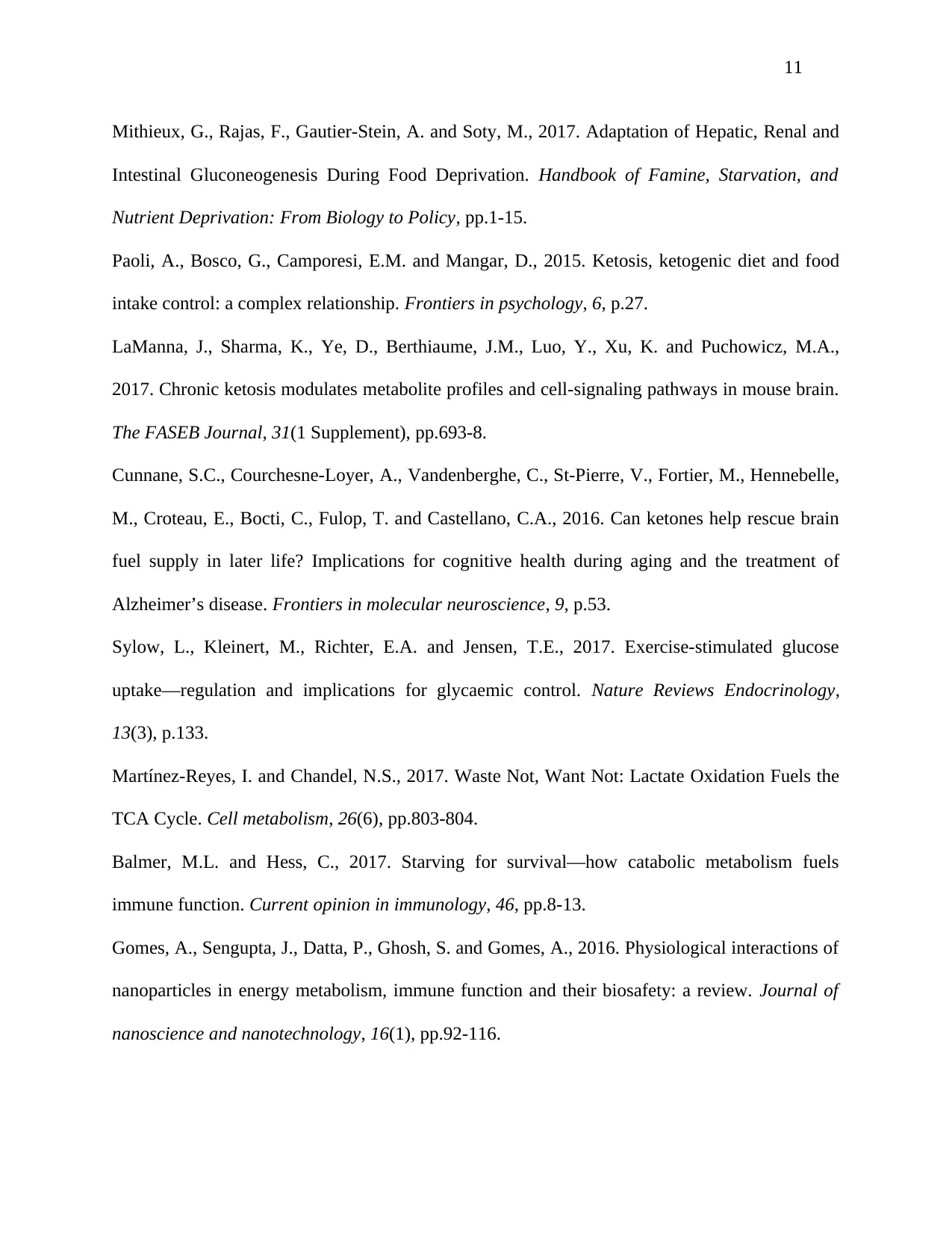
11
Mithieux, G., Rajas, F., Gautier-Stein, A. and Soty, M., 2017. Adaptation of Hepatic, Renal and
Intestinal Gluconeogenesis During Food Deprivation. Handbook of Famine, Starvation, and
Nutrient Deprivation: From Biology to Policy, pp.1-15.
Paoli, A., Bosco, G., Camporesi, E.M. and Mangar, D., 2015. Ketosis, ketogenic diet and food
intake control: a complex relationship. Frontiers in psychology, 6, p.27.
LaManna, J., Sharma, K., Ye, D., Berthiaume, J.M., Luo, Y., Xu, K. and Puchowicz, M.A.,
2017. Chronic ketosis modulates metabolite profiles and cell-signaling pathways in mouse brain.
The FASEB Journal, 31(1 Supplement), pp.693-8.
Cunnane, S.C., Courchesne-Loyer, A., Vandenberghe, C., St-Pierre, V., Fortier, M., Hennebelle,
M., Croteau, E., Bocti, C., Fulop, T. and Castellano, C.A., 2016. Can ketones help rescue brain
fuel supply in later life? Implications for cognitive health during aging and the treatment of
Alzheimer’s disease. Frontiers in molecular neuroscience, 9, p.53.
Sylow, L., Kleinert, M., Richter, E.A. and Jensen, T.E., 2017. Exercise-stimulated glucose
uptake—regulation and implications for glycaemic control. Nature Reviews Endocrinology,
13(3), p.133.
Martínez-Reyes, I. and Chandel, N.S., 2017. Waste Not, Want Not: Lactate Oxidation Fuels the
TCA Cycle. Cell metabolism, 26(6), pp.803-804.
Balmer, M.L. and Hess, C., 2017. Starving for survival—how catabolic metabolism fuels
immune function. Current opinion in immunology, 46, pp.8-13.
Gomes, A., Sengupta, J., Datta, P., Ghosh, S. and Gomes, A., 2016. Physiological interactions of
nanoparticles in energy metabolism, immune function and their biosafety: a review. Journal of
nanoscience and nanotechnology, 16(1), pp.92-116.
Mithieux, G., Rajas, F., Gautier-Stein, A. and Soty, M., 2017. Adaptation of Hepatic, Renal and
Intestinal Gluconeogenesis During Food Deprivation. Handbook of Famine, Starvation, and
Nutrient Deprivation: From Biology to Policy, pp.1-15.
Paoli, A., Bosco, G., Camporesi, E.M. and Mangar, D., 2015. Ketosis, ketogenic diet and food
intake control: a complex relationship. Frontiers in psychology, 6, p.27.
LaManna, J., Sharma, K., Ye, D., Berthiaume, J.M., Luo, Y., Xu, K. and Puchowicz, M.A.,
2017. Chronic ketosis modulates metabolite profiles and cell-signaling pathways in mouse brain.
The FASEB Journal, 31(1 Supplement), pp.693-8.
Cunnane, S.C., Courchesne-Loyer, A., Vandenberghe, C., St-Pierre, V., Fortier, M., Hennebelle,
M., Croteau, E., Bocti, C., Fulop, T. and Castellano, C.A., 2016. Can ketones help rescue brain
fuel supply in later life? Implications for cognitive health during aging and the treatment of
Alzheimer’s disease. Frontiers in molecular neuroscience, 9, p.53.
Sylow, L., Kleinert, M., Richter, E.A. and Jensen, T.E., 2017. Exercise-stimulated glucose
uptake—regulation and implications for glycaemic control. Nature Reviews Endocrinology,
13(3), p.133.
Martínez-Reyes, I. and Chandel, N.S., 2017. Waste Not, Want Not: Lactate Oxidation Fuels the
TCA Cycle. Cell metabolism, 26(6), pp.803-804.
Balmer, M.L. and Hess, C., 2017. Starving for survival—how catabolic metabolism fuels
immune function. Current opinion in immunology, 46, pp.8-13.
Gomes, A., Sengupta, J., Datta, P., Ghosh, S. and Gomes, A., 2016. Physiological interactions of
nanoparticles in energy metabolism, immune function and their biosafety: a review. Journal of
nanoscience and nanotechnology, 16(1), pp.92-116.
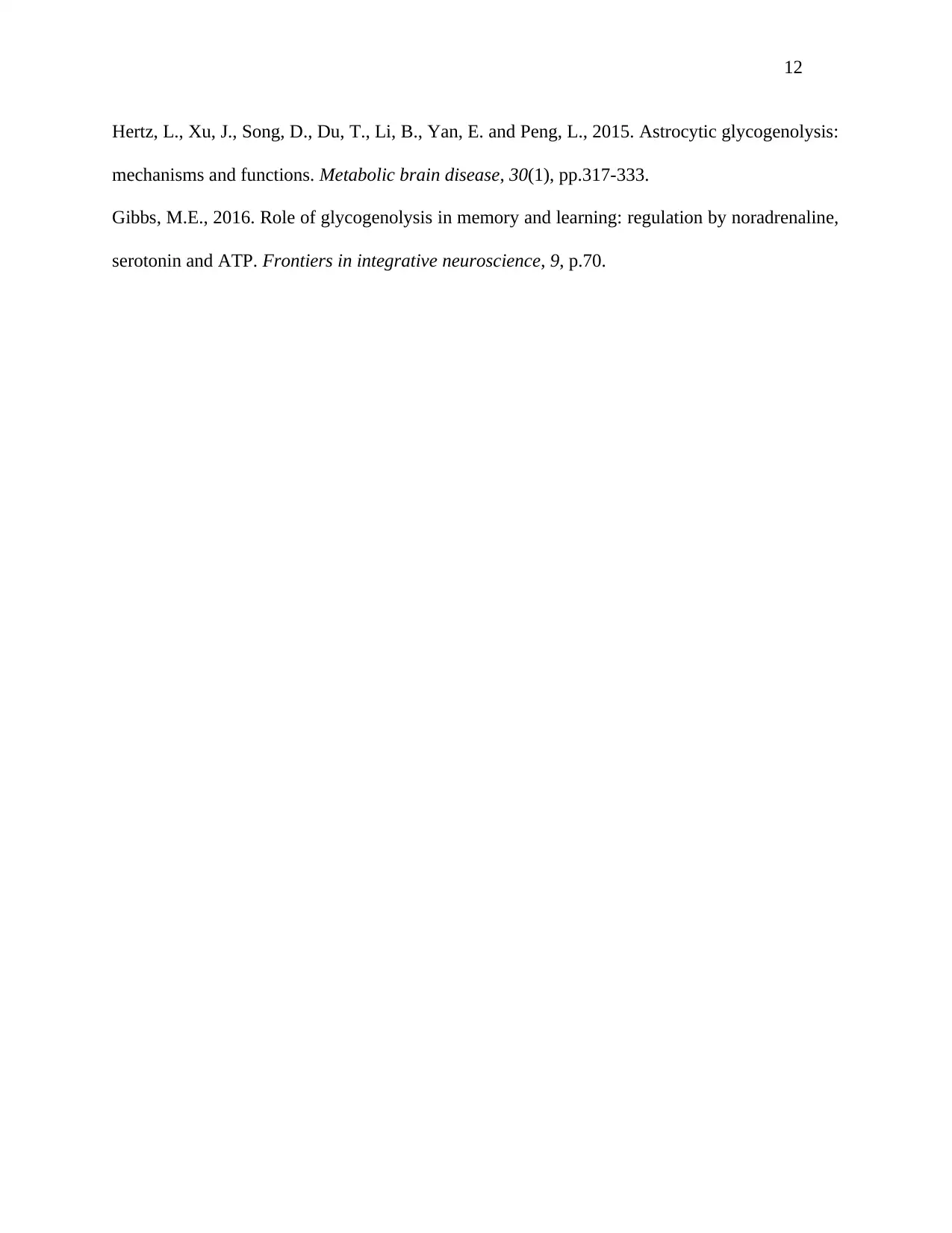
12
Hertz, L., Xu, J., Song, D., Du, T., Li, B., Yan, E. and Peng, L., 2015. Astrocytic glycogenolysis:
mechanisms and functions. Metabolic brain disease, 30(1), pp.317-333.
Gibbs, M.E., 2016. Role of glycogenolysis in memory and learning: regulation by noradrenaline,
serotonin and ATP. Frontiers in integrative neuroscience, 9, p.70.
Hertz, L., Xu, J., Song, D., Du, T., Li, B., Yan, E. and Peng, L., 2015. Astrocytic glycogenolysis:
mechanisms and functions. Metabolic brain disease, 30(1), pp.317-333.
Gibbs, M.E., 2016. Role of glycogenolysis in memory and learning: regulation by noradrenaline,
serotonin and ATP. Frontiers in integrative neuroscience, 9, p.70.
⊘ This is a preview!⊘
Do you want full access?
Subscribe today to unlock all pages.

Trusted by 1+ million students worldwide
1 out of 12
Related Documents
Your All-in-One AI-Powered Toolkit for Academic Success.
+13062052269
info@desklib.com
Available 24*7 on WhatsApp / Email
![[object Object]](/_next/static/media/star-bottom.7253800d.svg)
Unlock your academic potential
Copyright © 2020–2025 A2Z Services. All Rights Reserved. Developed and managed by ZUCOL.





